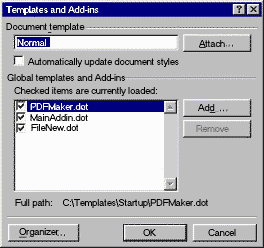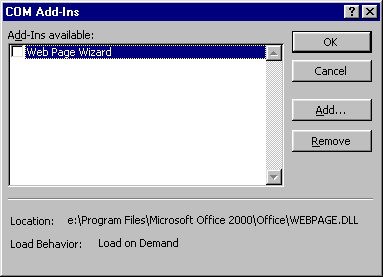How to find out whether any Word Add-ins have been installed
Or: I have new menu and toolbar items and I can't find out where they
came from
Or: Word started slowing down after I installed another program
Article contributed by Bob Buckland / updated by Lene Fredborg
Word Add-ins (unlike “normal” templates, which you see when you select File => New) enable people to add global functionality to Word. Other software vendors mean something similar when they refer to “plug-ins”, but Add-ins can be very basic, to the extent that ordinary Word users can create them.
There are two types of Word Add-ins:
- Global templates
- COM Add-ins
Global Templates
Global templates are stored in Word's Startup Folder(s). This is the only type of add-in supported by Word 97.

Global templates are the type of add-in that non-programmers can create, although they can also be very sophisticated indeed; and they appear in the listing of Tools => Templates and Add-ins in Word. The path where each add-in stored is shown at the bottom of the dialog when you click on the add-in's name.
To find out where your Startup path is, select Tools + Options + File Locations, and note the path listed under “Startup”. If you cannot see the full
path, double-click on it.
For help on finding the Startup folder in Word 2007 and later versions, see How to find the Word STARTUP folder.
Word 2000 and higher complicate things pointlessly and annoyingly; any .DOT files stored in C:\Program Files\Microsoft Office\Office\Startup (or equivalent, if you installed Word somewhere else) will be loaded as an Add-in, regardless of what your setting is under Tools + Options + File Locations + Startup. However, you can fix this by deleting any such files or, if you do want them loaded, by moving them into your “real” Startup folder.
Add-ins stored in the Startup folder are loaded automatically when Word starts ; but you can also store add-ins elsewhere and load them “on demand” at any time by clicking the “Add” button on the Templates and Add-ins dialog. For more on this, see: Organizing your macros.
As well as VBA code (macros), global templates can also store Autotext entries, and keyboard and toolbar customizations. Global templates are a safer place to store such things than Normal.dot, because they are less prone to corruption and virus infection..
COM Add-ins
COM Add-ins are DLL or ActiveX EXE files (only programmers can create these). These are not stored in Word's Startup Folder. The command that displays Word's COM Add-ins doesn't appear on a menu by default, but you can add it to the Tools menu (and thus find out whether you have any installed, and if you do, where they are stored) as follows:
- Open Word and go to the Tools => Customize menu and choose the Commands Tab.
- In the left pane choose the “Tools” category.
- In the right pane choose the “COM Add-Ins” command, click on it and while holding down the left mouse button drag it to your Tools menu, just below the “Templates and Add-ins” location.
Do I have a choice or a notification when some other program installs an Add-in?
Not always. Some software programs install Add-ins to enable them to integrate more effectively with Word . Some ask you if you want to go ahead, others just assume you do.
Why did Word slow down after the Add-In was installed?
Some Add-ins are inefficient.

Others are large and complex and take time to load. If the benefits of an Add-in aren't worth the added delay, you can remove a COM Add-in by choosing Tools => COM Add-ins, selecting the Add-in and clicking Remove. To remove a global template for the current Word session, you can select Tools => Templates and Add-ins and deselect the relevant checkbox; or to permanently remove it, you can move the Add-in file out of the Startup directory when Word is closed. (or if you're absolutely sure, you could delete the file).
